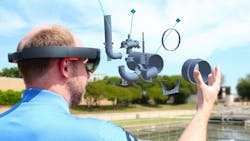Our Water Future Is Digital
Digital solutions are changing the way that clean, safe drinking water is delivered, infrastructure is maintained, and customers are served. As communities addressed COVID-19, digital investments that kept people connected and business operating were transformative. Forward-thinking utilities that proactively invested in smart solutions like advanced metering infrastructure (AMI) were able to continue customer service and billing, while others have gained remote access to connected sensors transmitting data streams that were monitoring real-time conditions and alerting staff to potential vulnerabilities, despite quarantine mandates.
Data is growing at its fastest rate ever. It is estimated that 2.65 quintillion bytes of data are created per day, empowering faster wireless networks and levels of data generation that had only before been imagined. This is just the beginning of the digital revolution.
HoloLens, VDC & Extended Reality
Engineering and construction of new water infrastructure has changed substantially due to the rise in digital solutions, and the pandemic has only accelerated this shift. It is no secret that digital tools help utilities design, build and operate more efficiently than ever before. They are no longer viewing 3D designs on a 2D screen; they are using 3-, 4- and 5D to ensure that they are optimizing the time line, total cost and efficiency gains for clients.
Technologies — such as HoloLens, virtual design and construction (VDC) tools and unmanned aerial vehicles equipped with sensors — can maintain and improve existing infrastructure projects. Recent breakthroughs in artificial intelligence (AI) and machine learning have even been proven to forecast asset failure and prevent water loss.
Augmented or ‘Extended Reality’ (XR) is not necessarily novel in the engineering world, but it is quickly gaining adoption. These devices beat the existing alternatives of tablets or cell phones because they offer a hands-free experience, so operators and maintenance staff can freely access equipment, chemicals and tools. They also offer video capture and real-time interaction from the first-person perspective, which proved invaluable last spring when global engineering projects came to a screeching halt.
For example, at the Wadi Arab water treatment plant, the CDM Smith team utilized HoloLens technology to visit the site remotely, so the team in Chicago could be “on site” in Jordan, despite international travel bans. Even outside of daily operational benefits, XR provides another hefty benefit: measurable improvements in cognitive retention at rates of up to 75%. CDM Smith has seen this impact with one of its Florida clients, where XR was used in place of traditional operational training methods. This translated into improved operating efficiencies and asset uptime, overall quality of operations and increased emergency response.
Drones & Aerial Photography
Today’s storm water managers need to understand the extent and location of impervious surfaces within their watersheds in order to combat the rise of flooding due to climate change and urbanization. Traditional aerial photography is expensive and can quickly become obsolete, so many are turning to the latest in drone technology. When equipped with lightweight sensors and multispectral cameras, small unmanned aerial systems (sUAS) become powerful real-time data collection tools that can provide up-to-date images in a timely and cost-effective manner.
Asset Management, Digital Twins & Advanced Analytics
Another trend on the rise is supplementing maturing asset management programs with advanced analytics and dynamic dashboards. Currently, CDM Smith is working in Hawaii to optimize a client’s data into a risk-based prioritization program, which will then be combined with the latest in satellite image processing and AI to identify replacement candidates according to leak potential.
Digital twins are rapidly changing the operation and maintenance of infrastructure assets. Data sets that replicate physical assets with ones and zeroes have the power to reduce costs, improve reliability and increase efficiency. One analysis predicted that 125 billion IoT connected devices will be in operation worldwide by 2030, which would further fuel digital twin adoption.
At the asset level, digital twins can be used to simulate pump performance based on energy optimization, generating tangible energy-driven cost savings and helping to extend the lifespan and uptime of the pumps. At the plant level, digital twins can simulate and forecast the water quality parameters within specific processes, which has the potential to optimize energy and chemical costs. Digital twin tools, like CDM Smith’s PipeCAST, provide an anywhere-access platform to evaluate performance following incidents, operations and maintenance activities, and hydraulically significant factors as well as forecast into the future to provide the ability for proactive action derived by data.
Smart water tools, whether digital twins or dashboards, break down the traditional silos — both cultural and structural — by integrating databases and information systems so institutional knowledge can be centrally captured and shared to help utilities navigate the ongoing “silver tsunami” of baby boomer retirements. Utilities that find modern ways to train staff and facilitate knowledge transfer will undoubtedly gain efficiencies compared to the ones whose outdated manuals and checklists are sitting on shelves collecting dust.
Virtual Public Meetings
Digital solutions provide unique opportunities to engage stakeholders, hold public meetings, and facilitate communication on a nearly 24/7 basis. Organizations have quickly realized that the sky is the limit for virtual events if they allow themselves to think outside the box. No longer will teams be limited in terms of speakers, locations, native languages or audiences.
Virtual public meetings were a necessity due to COVID-19 but, in truth, the technology was ready for it. The Gather tool, for example, provides the virtual experience of a public meeting without the tedious logistics coordination. Dashboards are another example. They reveal new insights for operations and management by combining data from traditionally disparate sources and serve as a strong stakeholder engagement tool by delivering immediate access and transparency.
With the public health threats associated with lead service lines (LSL), digital solutions are a valuable tool to both monitor progress and communicate to stakeholders. CDM Smith built a GIS-based dashboard integrated with a construction management system to track and verify the LSL replacement program in Newark, New Jersey, by tracking 100 replacements per day on a near real-time basis. CDM Smith also is tapping into the power of data visualization to communicate this progress and activity to impacted stakeholders via a dedicated tool where residents can check the status of their LSL replacement.
What is Water Infrastructure’s Digital Future?
There has been much talk of advancements in cloud conversion and satellite internet — both of which offer significant improvements in performance simulation and business continuity, but the future is even brighter.
All big tech companies are racing to establish a stronghold in the world of quantum computing. Regardless of whether Google or some other big tech giant gets there first, quantum computers offer hope in addressing the most complex optimization challenges that involve numerous variables. For example, successfully optimizing distribution or transportation logistics, energy consumption and weather could save organizations money and improve the environment.
The evolution of battery technology will significantly increase the number and usage of field sensors, providing more opportunities to enhance digital twins and related technology breakthroughs.
For water utilities that are exploring or expanding within the digital solutions realm, technological transparency is essential. Blockchain provides a much-needed level of security by diminishing the risk of hacking and allowing utilities to immediately access information and updates relating to client records.
Digital solutions have already demonstrated capabilities to use real-time data and advanced analytics to reduce costs, improve efficiencies and promote communication. As organizations embark on achieving their net-zero carbon emission goals, their assets will need to optimize performance and efficiency; digital twins and dashboards are key tools to enable that.
While the future of digital solutions is exciting to daydream about, the first step is clear: acknowledging the major challenges all water utilities face regarding equity in water services, financial resilience, PFAS, harmful algal blooms, the impacts of climate change, flooding and water scarcity.
All of these issues necessitate increased monitoring and data analysis in order to deliver the necessary insights to deliver solutions. Digital solutions will need to advance to match our goals and support our progress in these areas.
About the Author
Rajan Ray
Vice President of Strategy & Marketing
Rajan Ray is vice president of strategy and marketing for Trinnex, a subsidiary of CDM Smith. Ray can be reached at [email protected].
Amy Corriveau
director of digital solutions
Amy Corriveau is President of Trinnex, a subsidiary of CDM Smith. Corriveau can be reached at [email protected].

